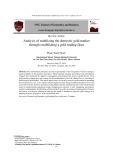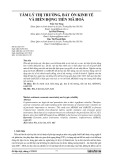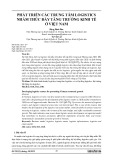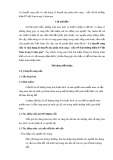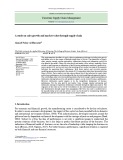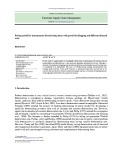
* Corresponding author Tel: +9821-88021067/ Fax: +9821-88013102
E-mail address:mrabani@ut.ac.ir (M. Rabbani)
© 2019 by the authors; licensee Growing Science, Canada
doi: 10.5267/j.uscm.2018.5.004
Uncertain Supply Chain Management 7 (2019) 33–48
Contents lists available at GrowingScience
Uncertain Supply Chain Management
homepage: www.GrowingScience.com/uscm
An inventory model with credit, price and marketing dependent demand under permitted delayed
payments and shortages: A signomial geometric programming approach
Masoud Rabbania* and Leyla Aliabadia
aSchool of Industrial Engineering, College of Engineering, University of Tehran, Tehran, Iran
C H R O N I C L E A B S T R A C T
Article history:
Received February 2, 2018
Accepted May 23 2018
Available online
May 29 2018
In this study, we incorporate trade credit policy into a joint marketing and pricing problem in
which demand rate depends on the length of the credit period provided by the retailer for her
customers, marketing expenditure, and selling price. The trade credit policy adopted here is a
delayed payment policy in partial form in which the customers must pay a percent of the total
purchasing cost at the time of placing an order and can pay the remaining amount later.
Shortages are allowed and partially backordered. The main objective of this study is to
determine the optimal credit period, marketing expenditure, selling price, and variables of
inventory control simultaneously in order to maximize retailer’s total profit. For solving the
proposed problem, first an approximation method is applied to simplify the profit function and
transform the problem into a constrained Signomial Geometric Programming (SGP) problem,
then a global optimization approach is used for solving the model. Finally, a numerical example
and sensitivity analysis of the important parameters are conducted to show the effectiveness of
proposed approach.
ensee Growin
g
Science, Canada
by
the authors; lic9© 201
Keywords:
Credit-dependent demand
Partial delayed payment
Partial backordering
Signomial geometric
programming
1. Introduction
In classic economic order quantity (EOQ) model, it is assumed that marketing strategies and production
are executed, separately. However, these two factors are inextricably interdependent. In this regard,
coordination of marketing strategies and production has an absolutely essential role in profit
maximization in competitive business world. The first study considered a model incorporating
production and marketing strategies was performed by Lee and Kim (1993). They assumed demand as
non-deterministic and expressed it as a power function of selling price and marketing expenditure. The
paper aimed to determine the marketing expenditure, selling price, demand and the order quantity in a
net profit – maximizing. After that, several researchers considered this assumption in their models
(Bayati et al., 2013; Sadjadi et al., 2010; Sadjadi et al., 2005; Samadi et al., 2013; Tabatabaei et al.,
2017). In today’s business transaction, it is very common to observe the customers who are not willing
to pay immediately after buying the goods or services and are allowed to delay their payments till the
end of the credit period. The customer pays no interest during the constant and predetermined period
of time in which they have to settle the account, but if the payment is delayed after the period, interest

34
will be charged. During permissible period the customer can sell or use the goods and keep on revenue
accumulation. Therefore, it is beneficial for the customer to postpone the payment to the supplier until
the end of the permissible period. Goyal (1985) was the first person who considered an allowed delay
in payment for customer in his model with general presumption of classic EOQ model. Afterwards,
Liao et al. (2000) explored a model for initial-stock-dependent consumption rate by considering delay
in payments. In their proposed model, shortages were not permissible. They also investigated the effect
of initial-stock-dependent consumption, inflation, deterioration rates, and delay on payment. Teng
(2002) modified the model discussed in Goyal (1985) by considering the distinction among unit price
and unit cost. Shinn and Hwang (2003) presented an EOQ model in which demand rate depends on the
selling price and credit period and credit period depends on the order quantity. Ho (2011) developed a
new mathematical formulation under two level of trade credit policy in which demand is sensitive to
the credit period offered by the retailer and selling price. Furthermore, many researches were studied
on this filed by considering different assumptions for payments (Ghoreishi et al., 2015; Jaggi et al.,
2015; Khanna et al., 2017; Sharma, 2016; Taleizadeh et al., 2013).
However, all the aforementioned studies mainly take the retailer’s perspective of obtaining the optimal
ordering policies under a predetermined delay period, but little is known about how to find the optimal
length of the delay period offered by the retailer to the customers. On the other hand, since a permissible
delay in payment leads to bring new customers and increase demand rate. Thus, in real-life situations
it is necessary to study the effect of delay period on the demand rate. In addition, an effective way to
show the effect of delay period on the demand rate and find the optimal delay period is to represent the
demand rate as power function of the length of delay period offered by the retailer, which is the first
main component of this paper.
The second main component of the proposed model is partial backlogging of demand. Shortages are
very significant, especially in an inventory model in which delay in payment is accepted, because
shortages can affect the order quantity to make more profit from the delay in payments (Jamal et al.,
1997). Montgomery et al. (1973) were the first who developed an inventory model by general
presumptions of the classic EOQ model under partial backlogging of demand. Nowadays, many
researchers consider shortages in their models, especially with different forms of payments such as
Tripathi (2012), Taleizadeh et al. (2013), Lashgari et al. (2016), Diabat et al. (2017), and Cunha et al.
(2018). For these studies, all assumed the fraction of shortage backordered is constant over time. This
assumption is not valid in the real markets. Usually, the backorder rate depends on the length of the
waiting time for the next replenishment and is a decreasing function of the waiting time. This
assumption is considered in the few studies such as Maihami and Abadi (2012)¸ Dye and Yang (2015),
Sharma (2016) , and Maihami et al. (2017). The third main component of the proposed model is to
apply appropriate approach for finding global optimal solutions. As an aforementioned, the demand
rate and unit cost are not constant and are represented as multivariate functions of different parameters.
These assumptions convert the model to a nonlinear programing problem. According to the literature,
to solve these kinds of nonlinear problems in inventory models Geometric Programing (GP) method is
applied frequently (El-Wakeel & Al Salman, 2018; Mandal, 2016; Sadjadi et al., 2010; Samadi et al.,
2013; Tabatabaei et al., 2017). GP problem was discovered by Zener (1971) for solving engineering
problems where objective functions were positive sums of log-linear functions. Signomial Geometric
Programming (SGP) problems were the first extension of GP problems that includes Signomial
expressions in the objective function and constraints (Passy & Wilde, 1967). This method has very
useful computational and theoretical properties to solve complex optimization problems in different
fields such as engineering, management, science, etc. This technique was extended rapidly by
researchers, especially engineering designers.

M. Rabbani and L. Aliabadi / Uncertain Supply Chain Management 7 (2019) 35
Table 1
The comparison table of related studies
Studies Demand Unit cost Delayed payment Backordering Backorder rate Decision variables Solved by
GP method
Full Partial Full Partial Credit
period
price Marketing
expenditure
Ho (2011) Price- credit
period -linked
Constant Yes No No No - No Yes No No
Taleizadeh et
al. (2013)
Constant Constant No Yes No Yes Constant No No No No
Samadi et al.
(2013)
Price- marketing
and service
expenditures -
linked
Order
quantity -
linked
No No Yes No Constant No Yes Yes Yes
Dye and Yang
(2015)
Credit period-
linke
d
Constant Yes No No Yes Waiting time-
dependent
Yes No No No
Jaggi et al.
(2015)
Price-linked Constant Yes No No No - No No No No
Sharma (2016) Constant Constant No yes No Yes Waiting time-
dependent
No No No No
Lashgari et al.
(2016)
Constant Constant Yes No Yes No - No No No No
Maihami et al.
(2017)
Price-linked Constant No Yes No Partial Waiting time-
dependent
No Yes No No
Tabatabaei et
al. (2017)
Price- marketing
expenditures -
linked
Order
quantity -
linked
No No No No - No Yes Yes Yes
This study Credit period-
price- marketing
expenditures -
linked
Order
quantity -
linked
No Yes No Yes Waiting time-
dependent
Yes Yes Yes Yes

36
The comparison table of related studies is given in Table 1. According to this table, demand is linked to
different parameters such as marketing expenditure, selling price, service expenditure, time, and delay
period. To the best of our knowledge, none of researchers has considered the effect of the length of credit
period offered by the retailer to its customers, marketing expenditure and selling price on demand
simultaneously in one model. For the first time, we propose a new inventory model under partial delayed
payments that considers demand as multivariate function of the credit period, marketing expenditure, and
selling price. In addition, in order to make the model more practical, it is assumed that shortages are
allowed and partially backordered in which the backorder rate is variable and depends on the waiting
time for the next replenishment. The unit purchasing cost is linked the order quantity. The main objective
of this study is to determine the optimal credit period, marketing expenditure, selling price, and variables
of inventory control simultaneously in order to maximize retailer’s total profit. For solving the proposed
problem, a global optimization of SGP problems is applied. The proposed model is based on the real
constraints and environments of manufacturing firms and suppliers such as automotive supplier firms
and drug manufacturers.
Given the literature, it is well-known that SGP problems are non-convex class of problems and an
inherently intractable NP-hard problem (Xu, 2014), for the reason finding a global optimal solution for
SGP problems are roughly difficult. In this technique degree of difficulty (DD = The number of decision
variables + the numbers of terms in objective functions and constraints -1) has an important role. When
2DD , many researchers have applied dual geometric programming for solving inventory models. But
if 3DD , solving inventory models will be difficult. Since the important section SGP problem is the
method used. Over the past decade, several researchers have considered this issue with interest for finding
global optimization strategies for these kinds of problems. In this study, we apply the proposed approach
by Xu (2014) in order to solve the presented model. This approach transforms the non-convex SGP into
series of standard GP problem to obtain a global solution.
The rest of this paper is organized as follows. We first describe the problem definition in Section 2.
Section 3 provides notations and model formulation. Then, the proposed model is solved using global
optimization approach in Section 4. In Section 5, numerical examples are conducted and also sensitivity
analysis of important parameters are presented. Finally, conclusion remarks and future works are
provided in Section 6.
2. Problem definition
Consider a supply chain consisting of the retailer and customers. In order to motivate customers and also
reduce default risks with credit-risk customers, the retailer offers a partial delayed payment for credit-
risk customers who must pay the percent of the total purchased amount at the time of receiving items
and then obtain a delay period of years on the remaining amount. The demand rate is sensitive to
selling price, credit period offered by the retailer, and marketing expenditure. Shortages are allowed and
partially backordered.
We also consider the following assumptions in our problem:
Demand ratecan be considered as a power function of credit period, marketing
expenditure, and selling priceby related elasticities that is determined by following equation:
VM G S
(1)
where is marketing size and 0, 0, 1
are the credit period, marketing expenditure and
selling price elasticity, respectively.
The unit purchasing cost
is a decreasing function of the order quantity as follows:
r
PUQ
(2)
where and 0
are scaling coefficient and discount coefficient, respectively.

M. Rabbani and L. Aliabadi / Uncertain Supply Chain Management 7 (2019) 37
The rate of backordered demand is a function of waiting time length for next replenishment, i.e.
t
te
, where tis the length of waiting time for next replenishment and 0
is backlogging
parameter.
The time horizon is infinite, the lead time is zero and the replenishment rate is instantaneous.
There is no deterioration.
In offering delayed payment to customers, the retailer endures a capital opportunity cost at rate p
I.
All parameters are supposed precise and constant.
3. Problem formulation
To formulate the problem, first the notations are introduced in Section3.1. Then the inventory model is
developed in Section3.2.
3.1. Notation
Parameters :
A
Ordering cost ($/order)
h Holding cost ($/unit/year)
Backorder cost ($/unit/year)
l
The cost of goodwill lost ($/unit)
p
I Rate of opportunity cost ($/year)
Selling price elasticity to demand
Marketing expenditure elasticity to demand
Credit period elasticity to demand
discount coefficient (the order quantity elasticity to unit cost)
The portion of the purchase cost that should be paid when an
order is placed (initial payment),
0,1
Decision variables:
P The portion of demand that will be satisfied from stock,
0,1P
T The length of an inventory cycle time
S The unit selling price
M
Credit period
G Marketing expenditure per unit item
Independent decision variable:
Demand rate per year
I
t The inventory level at time t
r
P
Unit purchasing cost ($/unit)
t
The fraction of shortages that will be backordered,
11,01 t
Q Order quantity
B
The maximum level of backordered demand
Z
Average annual retailer’s profit


